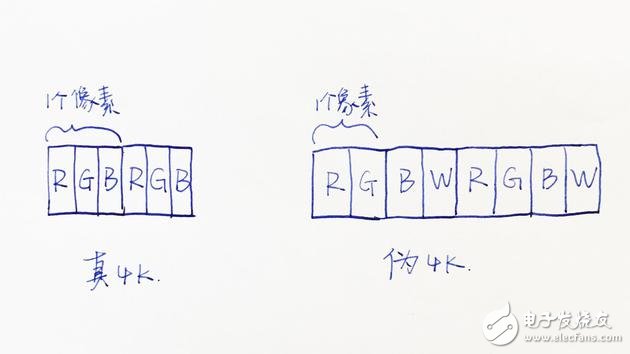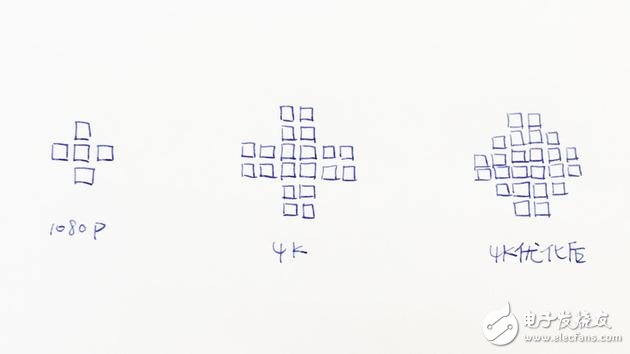Electronic enthusiasts eight o'clock early: I did not expect the old Yang to fill the pit so slow ~ I did not expect. In the last issue, we introduced the concern of the fans who stayed up late to buy TV. Today we talk about the home theater party. Telling the truth, at home to enjoy the effect of the film, the quality of the picture and the sound quality, both of which can be from both the source and the product, the product must be from the perspective of software and hardware... Speaking of this, most people may be familiar with the concept of resolution, which is the size of a popular video image. What 4K, 1080P, 720P are resolutions. Like 4K, FullHD, these names actually represent a range of resolution sizes, usually in terms of how many rows of pixels (pixels: digital images are made up of dense dots, this is called a pixel), For example, 4K has 2160 lines, and FullHD has 1080 lines. Then, according to the aspect ratio of the screen, how many columns of pixels are determined. For example, the 4K screen resolution of 16:9 is 3840*2160. So what is 1080P and 720P? This P represents progressive pixel scanning, that is, when the image changes, the first row of pixels changes color from left to right, then the second line... These changes are so fast that they give the impression of a continuous moving picture. Corresponding to P is I, that is, interlaced scanning, one or three five such jumps, and now there is basically no interlaced screen. So 4K we already know, what is pseudo 4K? According to the above, the 4K screen has a total of 3840*2160 pixels, and one pixel is composed of three sub-pixels of red, green and blue, then the 4K screen has a total of 3840*2160*3 sub-pixels. However, a few years ago, LCD technology was not so developed, the overall screen brightness could not be guaranteed, so the manufacturer inserted white or yellow sub-pixels between the red, green and blue sub-pixels, but the overall 3840*2160*3 sub-pixels. . This is 4 sub-pixels to make two pixels, whether it is color reproduction or clarity is slightly lacking compared to the real 4K, this is pseudo 4K. The major manufacturers tell you that quantum dots are a new material, and quantum dot materials of different sizes can emit more pure and bright light through illumination. However, as far as the current technology is concerned, the quantum dot screen still cannot escape the structure of the liquid crystal panel, and the quantum dot exists in the backlight layer in the form of a layer coating to improve the brightness of the backlight. The structure of the liquid crystal screen is the last layer of white light, and then the liquid crystal layer is rotated by the angle of the molecules to let the color to be displayed be cast. With the addition of this quantum dot film, the maximum brightness of the screen as a whole can be improved. Is the screen brightness high and the picture quality is good? Not absolutely. For example, the overall environment is relatively dark, so the improvement of image quality is affirmative. However, for the strong contrast between the light and dark, the details in the dark environment can finally be seen clearly because of the high brightness, but at this time the original bright place was overexposed. What HDR has to solve is to make the contrast between the light and the dark, and the darkness is clearer. It is technically done by backlighting. As mentioned above, the liquid crystal screen is mainly composed of a backlight and a "screen" of liquid crystal molecules, and the brightness of the backlight is initially unadjustable. Later, it is technically possible to detect the brightness of the overall picture, thereby realizing the adjustment of the entire backlight to match the picture. Since the beginning of the past two years, the backlight can achieve partitioning and control. That is to say, in an image with a large difference in brightness and darkness, the bright place turns the backlight up, and the dark place turns the backlight down or simply turns off. As I mentioned earlier, if the LCD wants to achieve a stronger contrast between light and dark, it is necessary to adjust the backlight layer. The structure of the OLED makes it more convenient when adjusting the brightness and darkness, because the OLED is a combination of a very small pair of light bulbs compared to the two-layer structure of the liquid crystal. Who is good and who is bad, in terms of current technological development, both have their own advantages. The LCD screen is brighter, and the picture quality does not decay over time, and the cost is lower. But the structure of the liquid crystal determines that it cannot be made very thin. OLED can be made thin, color performance is comparable to the same level of liquid crystal, but in the current technology, the brightness is too high, the product life is relatively low, and the cost of OLED panel is high, and the production capacity is limited. LCD and OLED image quality debate, has not stopped. This question is actually like asking, male and female who run fast, but the male and female have fat people who can't move, and there are professional athletes. Therefore, the quality of a TV is good, the panel can only play a part, and the optimization of the image quality in the later stage is also indelible. Why do many people say that Sony Dafa is good? In the field of TV products, Sony does not even develop panels themselves. This is not a foreign-style, foreign-made enterprise, and it is really not comparable to Sony in the research and development of image quality. Let Dafa TV be called faith, image quality chip is definitely one of the heroes. In the early years, Sony killed Sharp, the father of LCD in the field of television, which is the work of optimizing image quality. In addition to Sony, Hisense also announced the development of its own graphics chip the year before. Other manufacturers, although there is no separate chip, there will still be optimization algorithms in the system to optimize the picture. To be reasonable, if the source is good enough, then there is no need to adjust the color. but! The 4K TV is now in the sky, and the content in 4K resolution is very rare. China's cable TV signals are mostly 480P resolution. A few HD stations have a resolution of 720P and above. Even with the current Internet video content, the picture quality is mainly based on 1080P. So what the image quality engine needs to do is actually to optimize these 4K-free images to a 4K-like look and feel. The first is to sharpen the image. Everyone knows that a photo can be magnified infinitely on a computer, and a mosaic effect will appear. Playing 1080P and 720P videos on a 4K screen is the same effect. To make a simple analogy, a dot may occupy 5 pixels, but after stretching, if it is not processed, it is 20 pixels. To make this graphic look more like a circle, you need to fill up four pixels. By analogy, the image engine does this first. Second, the image is noise-reduced. We use a mobile phone to take a picture of the night sky. You can see that there are many dots of various colors in the black part of the sky. This is the point. And even professional equipment, there will be losses in the process of shooting or signal transmission, the TV quality engine to do is to remove these things like PhotoShop (although the effect is not as good as PS). Again, the image transition is more gradual. For example, the color in the sunset sky is gradual, but whether the signal loss or the ability of the panel itself is insufficient, it is easy to turn the sky into one piece. The image quality engine needs to make the transition look like a gradient instead of a step. Also, it is HDR optimization. The above explains what HDR is on the hardware, but more shades represent more colors. The original 8-bit binary number can cover these colors, and in HDR, you have to use more digits of binary digits to cover all colors. Our original color quantity standard is called SDR, now it is HDR. So what does it feel like to play SDR on an HDR device? If there is no optimization, then the TV should not be the same as the TV that does not support HDR. What the image quality engine needs to do is to calculate and stretch the SDR to the HDR standard. The above is not all that the image engine or image chip can do, but after watching the TV equipped with these technologies, you basically can't go back to the ordinary. These technologies are often found on flagship devices, and of course are expensive TVs. I just talked about the hardware and internal algorithm optimization of the TV, but if you use a TV to play a better source, this improvement is more obvious. For example, the same movie, you see the standard definition and play Blu-ray DVD on the website is absolutely different. The difference in source, most people may know the resolution parameter, which represents the size of the entire video. But the resolution is actually determined by another parameter, which is the code rate, in kbps. The larger the code rate, the clearer the image at the same resolution. Since I am watching a film at home, of course, the pursuit is to restore the effect of the theater as much as possible. But at present, the trend of TV getting thinner and thinner is actually contrary to the sound effect. This is also the reason why more and more split audio consoles have been used in these years. Studying the sound effect emphasizes the resonance between the cavity and the generating unit, and the sound source is divided into two channels, 2.1 channels (add a subwoofer outside the left and right channels), 5.1 (center channel, left front, left rear, right front, right rear and A subwoofer) and so on. A channel represents the sound coming from one direction. To put it simply, the appearance of the split SoundBar is similar to the improvement of the original speaker, and the effect is similar to the improvement of the bicycle to the electric car. But if you want to meet the standards of the car, please buy other audio and video equipment separately. Now TV basically supports audio decoding above 5.1 channels, and some also support Dolby panoramic sound. It is no problem to output such audio content, but the video that supports this audio standard is still poor. Ok, I’ve said a lot today. In the next issue, let’s talk about how the game party buys TV. Disclaimer: The electronic reprinted works of E-Commerce Network are as far as possible to indicate the source, and all rights of the owner of the work are not transferred due to the reprint of this site. If the author does not agree to reprint, please inform the site to delete or correct it. Reprinted works may be subject to change in title or content. Bi Directions Thyristor (Triac) Bi Directions Thyristor (Triac) is equivalent to the antiparallel connection of two unidirectional thyristors, but only one control pole. Bi Directions Thyristor,Electronic Components Triac,Power Thyristor For Inverter,Silicon Power Bipolar Transistors YANGZHOU POSITIONING TECH CO., LTD. , https://www.cndingweitech.com





Bidirectional thyristors are made of N-P-N-P-N five-layer semiconductor materials, and three electrodes are also derived from the outside. Its structure is shown in the figure. Bi-directional thyristor volt-ampere characteristic curve Since the forward and reverse characteristics of the bidirectional thyristor are symmetrical, it can be turned on in any direction and is an ideal AC switching device.